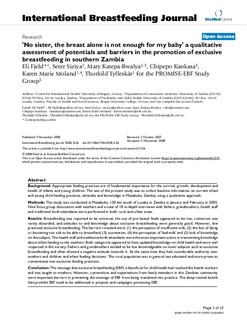'No sister, the breast alone is not enough for my baby' a qualitative assessment of potentials and barriers in the promotion of exclusive breastfeeding in southern Zambia
Fjeld, Eli; Siziya, Seter; Katepa-Bwalya, Mary; Kankasa, Chipepo; Moland, Karen Marie; Tylleskär, Thorkild
Peer reviewed, Journal article
Permanent lenke
http://hdl.handle.net/11250/2481746Utgivelsesdato
2008-10-05Metadata
Vis full innførselSamlinger
Originalversjon
doi:10.1186/1746-4358-3-26Sammendrag
Background: Appropriate feeding practices are of fundamental importance for the survival, growth, development and health of infants and young children. The aim of the present study was to collect baseline information on current infant and young child feeding practices, attitudes and knowledge in Mazabuka, Zambia, using a qualitative approach. Methods: The study was conducted in Mazabuka, 130 km south of Lusaka in Zambia in January and February in 2005. Nine focus group discussions with mothers and a total of 18 in-depth interviews with fathers, grandmothers, health staff and traditional birth attendants were performed in both rural and urban areas. Results: Breastfeeding was reported to be universal, the use of pre-lacteal feeds appeared to be low, colostrum was rarely discarded, and attitudes to and knowledge about exclusive breastfeeding were generally good. However, few practised exclusive breastfeeding. The barriers revealed were: (1) the perception of insufficient milk, (2) the fear of dying or becoming too sick to be able to breastfeed, (3) convention, (4) the perception of 'bad milk' and (5) lack of knowledge on the subject. The health staff and traditional birth attendants were the most important actors in transmitting knowledge about infant feeding to the mothers. Both categories appeared to have updated knowledge on child health and were well respected in the society. Fathers and grandmothers tended to be less knowledgeable on novel subjects such as exclusive breastfeeding and often showed a negative attitude towards it. At the same time they had considerable authority over mothers and children and infant feeding decisions. The rural population was in general less educated and more prone to conventional non-exclusive feeding practices. Conclusion: The message that exclusive breastfeeding (EBF) is beneficial for child health had reached the health workers and was taught to mothers. However, conventions and expectations from family members in this Zambian community were important barriers in preventing the message of EBF from being translated into practice. The deep-rooted beliefs that prohibit EBF need to be addressed in projects and campaigns promoting EBF.
Utgiver
BioMed CentralSerie
International Breastfeeding Journal2008, 3(26)
